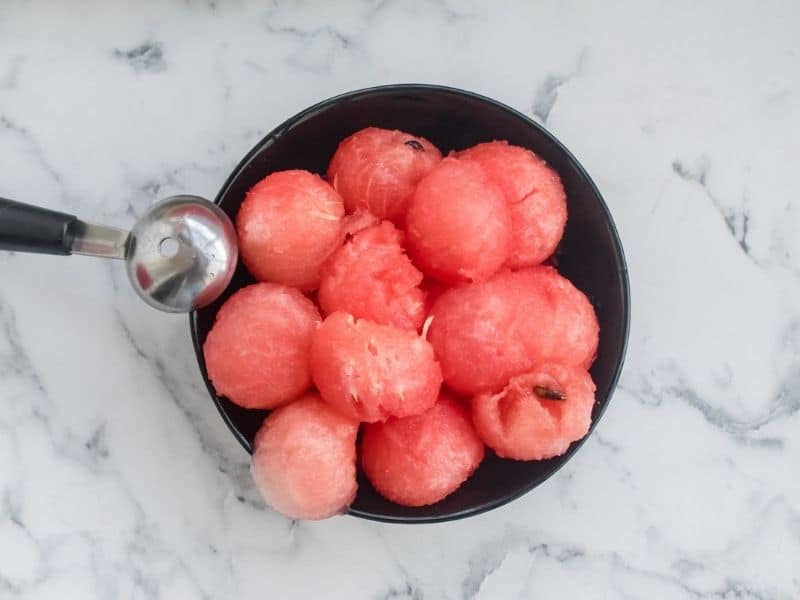Briefly, yes, watermelon can be frozen to extend its shelf life, but it will lose some of its firm texture and become more like solid ice blocks when thawed. However, there are various ways to enjoy frozen watermelon in different dishes after storing it in the freezer.
Sweet, plump, and juicy, nothing celebrates summer quite like watermelon. However, once these large pink melons are sliced, they spoil fairly quickly, even when kept in the refrigerator.
As its name suggests, watermelon consists of a high water content. Despite this, it can be frozen to extend its shelf life well into the winter months.
This allows you to get a taste of summer all year long and avoid wasting leftovers when the melon is just too big to consume before it starts spoiling.
In this step by step guide, you will learn how to preserve the melon in the freezer long-term and discover easy ways to use it after thawing.
Can Watermelon Be Frozen?
So, can you freeze watermelon?
Yes, watermelon can be frozen to extend its shelf life. Due to its high water composition, the melon pretty much turns into solid ice blocks on freezing and will lose some of its firm, plump texture once thawed.
Although this means watermelon won’t be quite the same after it has been frozen, there are many different and delicious ways to enjoy the pink melon after it has been stored in the freezer.
There are various methods to freeze watermelon depending on how you plan to use it later. Follow the below instructions carefully to ensure the watermelon stays well-preserved and does not develop freezer burn.
How To Freeze Watermelon
Watermelon should always be frozen freshly cut. If you are freezing watermelon leftovers that have already been sliced and refrigerated for a day, make sure it is still firm and slightly crisp.
Remove any soggy, sour, or soft parts as these will not freeze well and are prone to breeding harmful bacteria.
Step 1: Wash
Give uncut whole watermelon a good wash before handling.
Step 2: Peel and Cut
Cut the watermelon into quarters and remove the rind. Remove the hard, black seeds from the melon and cut it into cubes or slices. Alternatively, cut the watermelon in half and use a melon-baller to scoop out watermelon rounds, discarding the seeds.
Step 3: Prepare and Pack
Option 1: Flash Freezing Method
Once you have cut cubes, slices, or formed watermelon balls, spread them out in a single layer on a baking sheet lined with parchment paper or wax paper.
Optionally, you can toss the watermelon chunks in granulated sugar before placing it on the tray to assist in the preservation of the color and sweetness.
Place the lined baking sheet in the freezer for a few hours until the pieces are frozen. Remove the frozen watermelon cubes from the tray, pack the pieces into resealable freezer bags, and press out any remaining air before sealing tightly. You can also use an airtight container.
Top Tip: We recommend cutting watermelon into small cubes rather than large chunks to make it much easier to handle once frozen. Watermelon freezes extremely hard. Trying to place large frozen watermelon chunks into a smoothie blender will be like putting a massive piece of ice in a blender. Little watermelon cubes or balls are much more versatile.
Option 2: Sugar Syrup
Another way to preserve the watermelon flavor and texture is by submerging the fruit in a simple syrup. The result after thawing will be somewhat similar to canned fruit. It takes a little more prep time but is well worth the effort.
To make a light sugar syrup, combine 9 cups of water with 2 ¼ cups of granulated sugar (1200ml water and 425g sugar). Heat them together in a saucepan. Bring the mixture to the boil and stir until the sugar has completely dissolved. Once dissolved, the mixture will be clear or slightly white. Remove it from the heat and let it cool.
Portion the watermelon into airtight freezer-friendly containers or zip lock freezer bags. Pour the cooled syrup over the watermelon pieces until just covered.
If you are using an airtight container, place a piece of parchment paper against the surface of the fruit to keep it submerged and protected from air before closing the lid. If using a zip lock storage bag, press out any air before sealing the bag.
Option 3: Puree
Freezing pureed watermelon is perfect for making smoothies.
Place the cut watermelon in a blender and blitz until smooth. Alternatively use a juicer to make watermelon juice. Pour the puree (or juice) into an ice cube tray and place it in the freezer. Ensure that you freeze your watermelon completely.
Once fully frozen, remove the watermelon cubes from the tray and place them into a freezer bag, removing the air from the bag before sealing. You can also use a freezer safe container.
If preferred, you can also freeze the puree in larger portions instead of in ice cubes. Pour the puree into a ziplock freezer bag. Do not over fill the bag. Leave at least an inch of space unoccupied at the top. Watermelon expands on freezing and can burst the bag if filled to the brim. Make sure to press out the air from the top of the bag before sealing to prevent freezer burn.
Step 4: Label and Freeze
Regardless whether you use the flash freeze, simple syrup, or puree method, label the container or freezer bag with the date before placing it in the freezer. This way, you can keep track of how long the frozen watermelon has been stored.
How To Thaw Frozen Watermelon
Frozen watermelon is best used only slightly thawed to maintain a firm, chilled texture. When using watermelon in a smoothie, cocktails, to make sorbet, or in drinks, always use it from frozen. Fully thawed watermelon chunks are not appetizing to eat.
If you do want to thaw watermelon that has been preserved in a sugar syrup, place the container or freezer bag on a plate in the refrigerator overnight. Stir the mixture occasionally.
Types of Watermelon
Watermelon has a thick rind and juicy crisp center. They range from 20 cm (8 in) to over 60 cm (24 in) in diameter. The outer skin is usually mottled dark green with a white inner rind. The fruit flesh is commonly pink or red with black seeds, however, you also get seedless watermelon.
Watermelon is eaten plain sliced, in a fruit salad, as part of a fruit platter, candied, pickled, or preserved in sugar syrup as an addition to cheese platters, crackers, or bread. Watermelon is also popular in smoothies, juices, and cocktails.

FAQs
Conclusion
Although high in water content, fresh watermelon can be frozen to preserve its color and sweet fruity flavor. Preserving watermelon in a sugar syrup or coating it with granular sugar when freezing will enhance the color and flavor preservation.
It is also vital to protect the fruit from contact with air when freezing, by keeping it well sealed.
Whizz partially frozen watermelon ice cubes with other ingredients to make a refreshing watermelon smoothie or cocktail on a hot summer day. Other great ideas when freezing watermelon is to add a popsicle stick to your mold to create fruity pink watermelon popsicles or even a delicious melon sorbet.
Freeze leftover watermelon to enjoy summer sweetness all year long!
Up next: How to freeze cantaloupe
*image by artcasta&VeraChan/depositphotos









